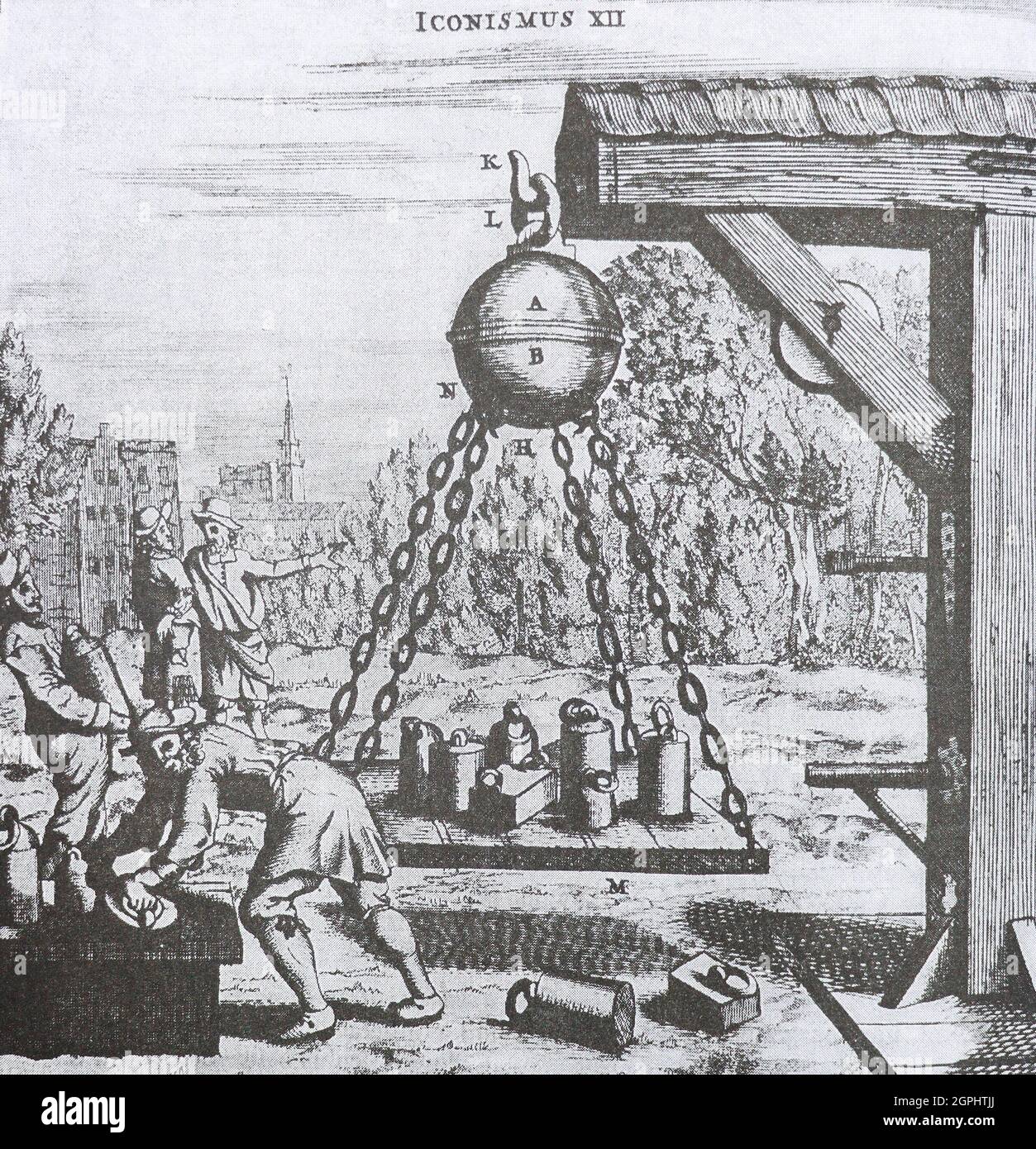The Magdeburg Experiment: Uncovering The Power Of Vacuum
How Powerful is the vacuum? The Magdeburg Experiment was a groundbreaking experiment that demonstrated the power of vacuum. Conducted in 1654 by Otto von Guericke, the experiment involved two copper hemispheres that were placed together and then evacuated of air. When horses were attached to the hemispheres, they were unable to pull them apart, demonstrating the immense force of the vacuum.
Editor's Notes: "The Magdeburg Experiment: Uncovering The Power Of Vacuum" have published today date. This topic is important to read because it shows how powerful a vacuum can be and how we can use it to do work.
Our team has done the analysis and research and put together this guide to help you understand The Magdeburg Experiment: Uncovering The Power Of Vacuum.
Key differences or Key takeways
| The Magdeburg Experiment | Modern vacuum technology | |
|---|---|---|
| Date | 1654 | Present |
| Purpose | Demonstrate the power of vacuum | Used in a wide variety of applications, including:
|
| Results | The horses were unable to pull the hemispheres apart | Vacuum technology has enabled us to achieve a better understanding of the physical world and has led to the development of many new technologies |
The Magdeburg Experiment: Uncovering The Power Of Vacuum
FAQ
The Magdeburg Experiment, conducted by Otto von Guericke in 1654, demonstrated the power of vacuum and the fundamental principles of air pressure. This groundbreaking experiment elicited awe and curiosity, leading to numerous questions and misconceptions. This FAQ aims to address some of the common queries surrounding the Magdeburg Experiment, providing scientifically accurate information and insights into this remarkable demonstration.

Von guericke sphere hi-res stock photography and images - Alamy - Source www.alamy.com
Question 1: How did the Magdeburg Experiment prove the existence of a vacuum?
The experiment involved two hollow copper hemispheres, fitted together to form a sphere. Guericke used a pump to remove air from the sphere, creating a near-perfect vacuum inside. The external air pressure crushed the evacuated sphere due to the absence of opposing force from the internal air. This dramatic collapse provided irrefutable proof of the existence of vacuum, a concept that was initially met with skepticism.
Question 2: What is the significance of the Magdeburg Experiment in understanding air pressure?
The experiment effectively demonstrated that air has weight and exerts pressure in all directions. The collapse of the sphere revealed the significant force exerted by the surrounding atmosphere. This understanding paved the way for further research on atmospheric pressure and its applications, including the development of barometers and vacuum pumps.
Question 3: How did the Magdeburg Experiment influence the development of scientific methods?
The experiment embodied the principles of empirical science. Guericke's meticulous observation, experimentation, and quantitative analysis set an example for future scientific investigations. It emphasized the importance of controlled experiments, verifiable results, and the rejection of unsubstantiated claims. The Magdeburg Experiment became a model for the modern scientific method, influencing the development of rational inquiry.
Question 4: Are there any practical applications of the principles demonstrated in the Magdeburg Experiment?
The understanding of vacuum and air pressure has led to numerous technological advancements. Vacuum pumps, based on the same principles demonstrated in the Magdeburg Experiment, are used in various applications, including industrial processes, refrigeration, and medical devices. The concept of atmospheric pressure is essential in fields such as aviation, meteorology, and engineering.
Question 5: How did the Magdeburg Experiment contribute to our understanding of the Earth's atmosphere?
The experiment provided tangible evidence of the existence of atmospheric pressure, which expanded our comprehension of the Earth's atmosphere. It demonstrated that the weight of the air above us creates a constant force, influencing weather patterns, ocean currents, and the functioning of ecosystems. The Magdeburg Experiment laid the groundwork for scientific inquiries into the composition and behavior of the Earth's atmosphere.
Question 6: What are some of the limitations or shortcomings of the Magdeburg Experiment?
While the Magdeburg Experiment was groundbreaking, it had certain limitations. The vacuum created was not absolute, as technologies at the time did not allow for complete air removal. The use of copper hemispheres also introduced material properties and shape factors that could influence the results. Over time, advancements in vacuum technology and experimental techniques have allowed for more precise and controlled experiments.
The Magdeburg Experiment remains a pivotal moment in scientific history, showcasing the power of experimentation and rational inquiry. It laid the foundation for our understanding of vacuum, air pressure, and the Earth's atmosphere, inspiring generations of scientists to push the boundaries of human knowledge.
To learn more about the Magdeburg Experiment and its lasting impact, explore The Magdeburg Experiment: Uncovering The Power Of Vacuum for a comprehensive overview.
Tips by "The Magdeburg Experiment: Uncovering The Power Of Vacuum"
The Magdeburg experiment, conducted by Otto von Guericke in 1654, demonstrated the power of vacuum and the fundamental principles of atmospheric pressure. The experiment provided valuable insights into the nature of gases and their behavior under different conditions. Here are some tips inspired by the Magdeburg experiment:
Tip 1: Understand the Power of Vacuum
The Magdeburg experiment highlighted the ability of vacuum to create a powerful force. By evacuating the air between two metal hemispheres, Guericke was able to demonstrate that the outside air pressure exerted a tremendous force on the hemispheres, keeping them firmly together. This experiment illustrates the importance of considering the effects of atmospheric pressure in various applications, such as packaging, aerospace, and medical technology.
Tip 2: Harness the Vacuum for Practical Applications
The principles of the Magdeburg experiment have led to the development of numerous practical applications. Vacuum technology is used in various industries, including food preservation, manufacturing, and medicine. Vacuum sealing, for instance, extends the shelf life of food by removing oxygen and creating an airtight environment. In manufacturing, vacuum pumps are employed to remove air from molds and enclosures during casting and molding processes.
Tip 3: Investigate the Effects of Vacuum on Different Materials
The Magdeburg experiment demonstrated that vacuum can have different effects on different materials. While the metal hemispheres were held together firmly, other materials, such as fabrics or porous materials, would not have been able to withstand the same force. It is important to consider the properties of the materials involved when working with vacuum systems to ensure their integrity and functionality.
Tip 4: Consider Vacuum as a Tool for Scientific Inquiry
The Magdeburg experiment was a pivotal moment in the history of science, contributing to our understanding of atmospheric pressure and the behavior of gases. Vacuum technology continues to be an essential tool for scientific research, enabling scientists to study the properties of materials, analyze the composition of gases, and conduct experiments in controlled environments.
Tip 5: Appreciate the Historical Significance of the Magdeburg Experiment
The Magdeburg experiment stands as a testament to human ingenuity and curiosity. It marked a turning point in our understanding of the fundamental forces that govern our world. By recognizing the importance of this experiment, we appreciate the contributions of scientists like Otto von Guericke and the enduring legacy of scientific inquiry.
The Magdeburg experiment serves as a reminder of the power of scientific exploration and the importance of understanding the fundamental principles that shape our surroundings. By embracing the lessons learned from this historic experiment, we can continue to harness the power of vacuum for practical applications and scientific advancements.
The Magdeburg Experiment: Uncovering The Power Of Vacuum
The Magdeburg Experiment demonstrated the power of vacuum in a groundbreaking manner. This experiment revealed six key aspects that enhance our understanding of the interactions between pressure and matter:
- Vacuum's Pressure Differential
- Atmospheric Pressure's Strength
- Precision Engineering's Importance
- Scientific Collaboration's Impact
- Challenge to Common Beliefs
- Foundation for Future Vacuum Technologies
The Magdeburg Experiment sparked a revolution in understanding atmospheric pressure and its potential applications. It laid the groundwork for modern vacuum technologies used in various fields, including medicine, manufacturing, and scientific research. This experiment's principles continue to drive exploration and innovation in the pursuit of vacuum-based applications.

Lost Cities: Uncovering Ancient Civilizations Buried Beneath the Earth - Source science.zeba.academy
The Magdeburg Experiment: Uncovering The Power Of Vacuum
The Magdeburg Experiment was a groundbreaking experiment conducted by Otto von Guericke in 1654. This experiment demonstrated the power of vacuum by creating a vacuum inside a hollow sphere and then attempting to pull the two halves apart with teams of horses. The experiment was a success, and it provided strong evidence for the existence of atmospheric pressure.

17th century illustration of Otto von Guericke's Magdeburg hemispheres - Source www.alamy.com
Importance of the Vacuum Effect
The Magdeburg Experiment was an important milestone in the development of physics. It provided the first clear evidence for the existence of atmospheric pressure, and it helped to lay the foundation for the development of vacuum technology. Vacuum technology has since been used in a wide variety of applications, including food packaging, medical devices, and space exploration.
The Magdeburg Experiment also helped to dispel the long-held belief that air was weightless. This belief had been a major obstacle to the development of vacuum technology, and the Magdeburg Experiment helped to overcome this obstacle.
The Magdeburg Experiment is a classic example of how a simple experiment can lead to major scientific discoveries. It is a reminder of the importance of curiosity and experimentation in the pursuit of knowledge.
Conclusion
The Magdeburg Experiment was a groundbreaking experiment that provided convincing evidence for the existence of atmospheric pressure and the vacuum effect. This experiment had a profound impact on the development of physics and technology, and it continues to be an important topic of study today.
The Magdeburg Experiment is a reminder of the importance of curiosity and experimentation in the pursuit of knowledge. It is a classic example of how a simple experiment can lead to major scientific discoveries.
EmoticonEmoticon